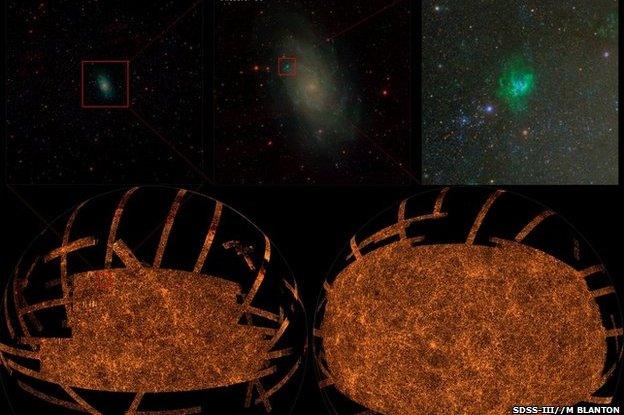Sloan data yields biggest colour night-sky image ever
- Published

Successive zooming in on the image of the Southern Galactic Cap (lower left) shows the Messier 33 galaxy (upper left; a further magnification at centre), and even the NGC 604 "stellar nursery"
Astronomers have released the largest ever colour image of the whole sky, stitched from seven million images, each made of 125 million pixels.
The Sloan Digital Sky Survey's latest effort tops its own record, published publicly, external for professional astronomers and "citizen scientists" alike.
Data from Sloan has helped to identify hundreds of millions of cosmic objects.
The release was announced at the 217th annual meeting of the American Astronomical Society in Seattle, US.
Researchers have released an animation on YouTube, external demonstrating how the incredibly high-resolution image is represented on the celestial sphere.
Michael Blanton, a New York University physicist who presented the work on behalf of the Sloan team, told the conference that it was difficult to overstate the breadth of data Sloan provided.
"There's something like 3,500 papers that have been written on the basis of this data set," he said.
"A few dozen of them are being presented right now, this week at this meeting. They cover topics from the very smallest stars to the most massive black holes in the universe."
Marek Kukula, Royal Greenwich Observatory: "You can see individual stars, galaxies - the detail is incredible"
Nearly half a billion stars and galaxies have already been discovered and described thanks to Sloan images, and the new release is sure to significantly increase that number.
Sloan data is also behind the Google Sky service, which allows users to scan the heavens in the same way as scanning their local streets, and the Galaxy Zoo project, external, which has allowed astronomy enthusiasts to characterise galaxies from their own computers.
Digital record
The workhorse behind the data set, a camera comprising 125 million pixels that long held the record for highest-resolution camera in the world, has been retired.
Studies will now focus on spectrometry - unpicking new data on the basis of the colours of light that the upgraded equipment can detect.
They include:
the Baryon Oscillation Spectroscopic Survey, which will study the periodic ripples that were left behind in the early days of the Universe
the Sloan Extension for Galactic Understanding and Exploration that measures the evidence of small galaxies on the edge of our Milky Way being swallowed up
the APO Galactic Evolution Experiment, which will study red giant stars within our Galaxy to better understand the Milky Way's overall chemical recipe
the Multi-object APO Radial Velocity Exoplanet Large-area Survey, which will spot giant planets outside our Solar System in a bid to better model how planets form
But even the data that is already available, thanks to Tuesday's release, will keep astronomers of both the professional and the amateur variety busy.
"You can compare it to the National Geographic Palomar Survey of the late 1950s," Dr Blanton said.
"This is something that 50 years later is still a really important reference to astronomers; we use it ourselves to better understand our own images. SDSS is the digital version of that."
- Published22 June 2010